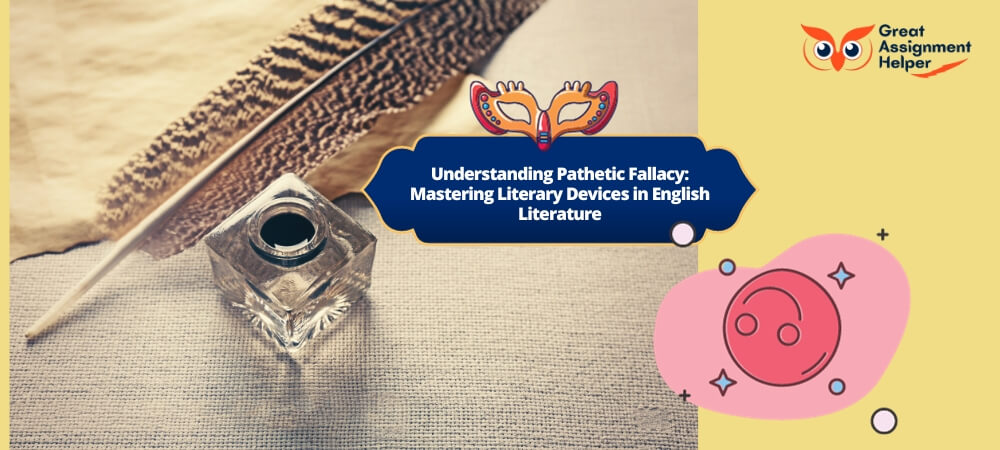
Listen To This Blog
Introduction
In the realm of literary expression, the concept of "Pathetic Fallacy" emerges as a fascinating and intricate element, weaving a tapestry of emotional depth and vivid imagery within narratives. This artistic technique breathes life into the inanimate, allowing nature and objects to mirror human emotions, thereby enriching the storytelling experience. As we delve into this literary phenomenon, we uncover how it subtly shapes the reader's perception, creating a resonant and immersive atmosphere. The use of Pathetic Fallacy extends beyond mere decorative language, serving as a conduit for deeper understanding and connection with the characters and their experiences. In this exploration, we will unravel the nuances of this literary device, observing its impact and significance in various works, and appreciating its role in enhancing the emotional landscape of storytelling.In the realm of literary expression, the concept of "Pathetic Fallacy" emerges as a fascinating and intricate element, weaving a tapestry of emotional depth and vivid imagery within narratives. This artistic technique breathes life into the inanimate, allowing nature and objects to mirror human emotions, thereby enriching the storytelling experience. As we delve into this literary phenomenon, we uncover how it subtly shapes the reader's perception, creating a resonant and immersive atmosphere. The use of Pathetic Fallacy extends beyond mere decorative language, serving as a conduit for deeper understanding and connection with the characters and their experiences. In this exploration, we will unravel the nuances of this literary device, observing its impact and significance in various works, and appreciating its role in enhancing the emotional landscape of storytelling.
What is Pathetic Fallacy
Definition and Essence
Pathetic fallacy is a literary device where emotions are attributed to elements of nature or inanimate objects. This technique breathes life into the non-human aspects of a story, allowing them to mirror or contrast the emotional landscape of characters or the narrative's mood.
Key Characteristics
- Emotional Projection: It involves projecting human feelings onto aspects of nature, like a gloomy sky reflecting sorrow.
- Enhancing Atmosphere: This device is pivotal in setting the tone of a scene, be it joyous, somber, or foreboding.
- Reflecting Inner States: Often, the external environment in a story mirrors the internal emotional state of characters.
Usage in Literature
Pathetic fallacy is prevalent in various literary genres, especially in works where nature plays a significant role. It's used to deepen the reader's engagement with the narrative by creating a resonant emotional environment.
Impact on Storytelling
By personifying nature and objects, writers create a more immersive and emotionally rich narrative experience. This technique adds depth and vividness, making the story more relatable and impactful for the reader.
In summary, pathetic fallacy is a powerful tool in a writer's arsenal, used to infuse emotional depth and complexity into a narrative, thereby enriching the reader's experience and connection to the story.
Pathetic Fallacy vs. Personification
|
Aspect |
Pathetic Fallacy |
Personification |
|---|---|---|
|
Definition |
A specific type of personification where emotions are attributed to nature, inanimate objects, or animals. |
A broader literary device that ascribes human qualities, actions, or emotions to non-human entities. |
|
Focus on Emotion |
Primarily involves attributing human emotions to non-human elements. |
Can involve any human characteristic, not limited to emotions. |
|
Usage in Literature |
Often used to mirror the emotional state of characters or the atmosphere of the scene. |
Used to bring life to inanimate objects or abstract concepts, making them relatable. |
|
Examples |
"The angry clouds loomed overhead." |
"The clock danced past midnight." |
|
Effect on Narrative |
Creates a mood or tone that reflects the inner feelings of characters or the thematic elements of the story. |
Adds depth and creativity to the narrative, making descriptions more vivid and imaginative. |
|
Common in Genres |
Frequently found in romantic and Gothic literature, where nature's mood is reflective of the narrative. |
Used across various genres to add personality and depth to non-human elements. |
Pathetic Fallacy Examples in Modern Contexts

Pathetic fallacy, a literary device that attributes human emotions to inanimate objects or nature, can be creatively applied in various modern contexts. Here are some examples:
Technology's Mood
- The Cheerful Phone: "My phone buzzed with a cheerful tone, as if excited to deliver the message."
- The Sullen Laptop: "The laptop's screen flickered sullenly, mirroring my frustration with the unending work."
Urban Landscape's Emotions
- The Melancholic Streets: "The city streets lay melancholic under the dim streetlights, echoing the loneliness of the night."
- The Jubilant Buildings: "Skyscrapers reached towards the sky in jubilation, basking in the glory of the bustling city life."
Nature's Reflection
- The Angry Storm: "The storm clouds gathered angrily overhead, mirroring the turmoil I felt inside."
- The Joyful Breeze: "A joyful breeze danced through the trees, celebrating the arrival of spring."
These examples demonstrate how pathetic fallacy can be used to convey emotions through various elements, from technology to urban settings and nature, enriching the narrative and connecting the reader to the underlying emotional tone of the content.
Technology's Mood: A Reflection of Human Emotion
Embracing Emotional Intelligence In the realm of technology, the integration of emotional intelligence has become a pivotal aspect. As machines learn to interpret and respond to human emotions, they offer a more intuitive and empathetic user experience. This evolution marks a significant leap from traditional, rigid programming to a more fluid, human-centric approach.
Personalization and Empathy
- Adaptive Interfaces: Technologies now adapt to our emotional states, altering interfaces to suit our moods. This personalization enhances user engagement and satisfaction.
- Empathetic AI: Artificial Intelligence systems are being trained to recognize and react to human emotions, paving the way for more compassionate and understanding interactions between humans and machines.
Enhancing User Experience The incorporation of emotional awareness in technology has revolutionized user experience. Devices and applications are no longer just tools; they are companions that understand and adapt to our emotional needs. This shift not only makes technology more accessible but also more relatable.
In conclusion, the infusion of emotional intelligence into technology reflects a significant advancement. It's a step towards creating a harmonious relationship between humans and machines, where technology not only understands our commands but also our emotions.
Urban Landscape's Emotions: A Vivid Portrayal
The Pulse of the City The urban landscape is a tapestry of emotions, each street and skyscraper echoing the collective heartbeat of its inhabitants. The bustling avenues, alive with the rhythm of footsteps and the melody of city life, reflect the dynamic energy of daily routines.
Whispers of History In the quieter corners, old buildings whisper tales of the past, their worn facades holding memories of yesteryears. These historical landmarks stand as silent observers, their presence a comforting reminder of the city's enduring spirit.
Nature's Touch in the Urban Amidst the concrete jungle, pockets of greenery offer a serene oasis. Parks and gardens, with their lush foliage and blooming flowers, provide a tranquil contrast to the urban rush, embodying the city's resilience and adaptability.
The Night's Transformation As dusk falls, the city transforms. The glow of streetlights and neon signs paint the night, creating a dreamscape of light and shadow. This nocturnal beauty captures the city's dual nature - vibrant yet mysterious, bustling yet peaceful.
In every aspect, the urban landscape is a living entity, its emotions woven into the very fabric of the city, offering a rich and complex narrative to those who traverse its paths.
Nature's Reflection: A Symphony of Emotions
Embracing the Mood Nature often acts as a mirror, reflecting the myriad emotions and states of being experienced by characters in literature. This phenomenon, known as pathetic fallacy, sees the natural world imbued with human feelings, creating a resonant and emotive backdrop.
The Dance of Elements
- Storms of Turmoil: Thunderous storms and howling winds often symbolize inner turmoil or foreshadow impending chaos.
- Sunshine of Joy: A bright, sunny day can represent happiness, hope, or a new beginning, infusing the narrative with positivity.
- Whispers of the Breeze: A gentle breeze might suggest tranquility or the soft whispers of secrets, adding layers of subtlety to the story.
Nature as a Storyteller In this dance of elements, nature becomes an active storyteller. It's not just a setting but a character that interacts with and enhances the human experience. Through this interaction, readers gain a deeper understanding of the characters' emotions and the overall tone of the narrative.
Conclusion Nature's reflection in literature is a powerful tool, capable of conveying complex emotions and themes. It enriches the narrative, making it more vivid and relatable, and allows the natural world to speak in a language of emotions understood by all.
Wrapping Up: The Art of Pathetic Fallacy in Literature
As we conclude our exploration of pathetic fallacy, it's essential to recognize how this literary device enriches storytelling. By attributing human emotions to nature and inanimate objects, authors create a resonant tapestry that vividly portrays the emotional landscape of their characters. This technique is particularly beneficial in English assignments, where the depth and complexity of literary analysis are paramount. For students grappling with such assignments, understanding and effectively analyzing pathetic fallacy can significantly enhance their interpretative skills and insights into the text.
In tackling these challenging aspects of literature, students often seek reliable and expert guidance. This is where GreatAssignmentHelper steps in as a valuable resource. As a seasoned English assignment help service provider, they offer specialized assistance in English literature, helping students to navigate through the nuances of literary devices like pathetic fallacy. Their expertise not only aids in comprehending the intricate layers of literary works but also in crafting well-informed and analytically rich assignments. Whether it's deciphering Shakespeare's use of nature to reflect turmoil or Shelley's employment of the environment to set a Gothic mood, greatassignmenthelper.com provides the necessary support to elevate students' academic endeavors in English literature.

